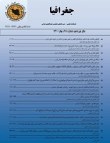Geoeconomical Structure of the Middle East (Basing on the Millennium Goals of the United Nation)
Author(s):
Abstract:
Middle East is one of the dispute and crisis core in the world. This region in the end years of 20th century and the beginning years of 21st century was involved in many crises. It is a fact that no region in the world like Middle East had been encountering with disputes. It, especially after the Second World War, was always the bed of political, martial and economical changes and never be decreased these changes intensity. But, some of these changes in the Middle East like war, disputes and conflicts always, reflexes in national, regional and international scales; whereas, the process of geoeconomical changes in the Middle East are less mentioned. In the present paper, in addition to qualify the geopolitical and geoeconomical structure of the middle east and its landscape, using descriptive-analytical method, it will be explained effective factors in the development certainty of this region according to the united nations standards of the millennium development goals. It is supposed that the population increasing process, shortage of resources in some countries of the Middle East and lake of democracy and legality make effects on the geopolitical and geoeconomical structure of the Middle East.Research findings indicate that the countries of Middle East and North Africa don’t have same and equal sources. These countries in the millennium development goals were studied geoeconomicaly as the countries of rich sources and labor forces, rich sources and poor labor forces and poor sources and poor labor forces. According to before mentioned contents, the purposes of this paper are:1. Explaining the geoeconomical place of Middle East between other regions that are classified in United Nation's millennium development goals, and2. Analyzing the out look of the geoeconomical place of Middle East and factors which influence that out look.In this way, in this article with a descriptive-analytical method and applying library sources, at first, related books, articles and specially UN's bulletins and printed information were studied and accessing some statistics creditable internet sites were used. In the first step, the lack of stable definition of Middle East makes difficulties. Then, we try to determine this region in the theoretical foundations. In the second step, we work out geoeconomical statistics and with a glance to existing situation of development in the countries of Middle East and North Africa it was cleared that there is a geoeconomical difference and this factor makes several problems between these countries in convergence process. The mentioned hypothesis were examined through the analysis of these countrie's gross income and existing situation of development, and also extraneous variables like the lack of democracy and legibility and low economical growth were theoretically studied. Finally, the unemployment growth arising from educated urban population growth is studied as an important factor in geoeconomical challenges of Middle East and North Africa which mentioned in the conclusions.
Keywords:
Language:
Persian
Published:
Geography, Volume:10 Issue: 34, 2012
Page:
233
magiran.com/p1049420
دانلود و مطالعه متن این مقاله با یکی از روشهای زیر امکان پذیر است:
اشتراک شخصی
با عضویت و پرداخت آنلاین حق اشتراک یکساله به مبلغ 1,390,000ريال میتوانید 70 عنوان مطلب دانلود کنید!
اشتراک سازمانی
به کتابخانه دانشگاه یا محل کار خود پیشنهاد کنید تا اشتراک سازمانی این پایگاه را برای دسترسی نامحدود همه کاربران به متن مطالب تهیه نمایند!
توجه!
- حق عضویت دریافتی صرف حمایت از نشریات عضو و نگهداری، تکمیل و توسعه مگیران میشود.
- پرداخت حق اشتراک و دانلود مقالات اجازه بازنشر آن در سایر رسانههای چاپی و دیجیتال را به کاربر نمیدهد.
دسترسی سراسری کاربران دانشگاه پیام نور!
اعضای هیئت علمی و دانشجویان دانشگاه پیام نور در سراسر کشور، در صورت ثبت نام با ایمیل دانشگاهی، تا پایان فروردین ماه 1403 به مقالات سایت دسترسی خواهند داشت!
In order to view content subscription is required
Personal subscription
Subscribe magiran.com for 70 € euros via PayPal and download 70 articles during a year.
Organization subscription
Please contact us to subscribe your university or library for unlimited access!


